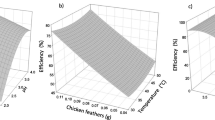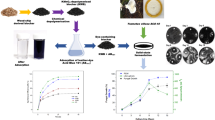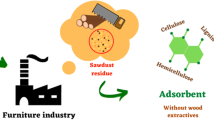Abstract
This research focuses on the removal of diclofenac in aqueous phase using chicken feathers and the evaluation of the subsequent biodegradation of the obtained adsorbate/adsorbent complex using a bacterial consortium. In the first stage, the conditions that affected adsorption were evaluated, in order to optimize the loading of the feathers. Afterwards, the equilibrium was evaluated by three adsorption isotherms at 8, 15 and 25 °C; the experimental data were explained by the Langmuir model, showing that, at 8 °C the highest load was obtained (614.8 mg/g). Additionally, the process was thermodynamically explained as spontaneous and exothermic and governed by chemical and physical processes, in addition to the occurrence of a decrease in molecular disorder at the adsorbate–adsorbent interface. Likewise, the kinetic behavior was studied at 8, 15 and 25 °C, detecting that the adsorption process occurs in two stages described by the intraparticle diffusion model. Finally, an FTIR analysis was carried out, in which the groups participating in the adsorption process were shown. The second stage was the evaluation of the biodegradation process of the adsorbate/adsorbent complex. The biodegradation of diclofenac was evidenced by monitoring laccase, lignin peroxidase, manganese peroxidase and polyphenol oxidase enzymatic activities and quantifying the 50% decrease in diclofenac concentration by HPLC. Simultaneously, the degradation of the chicken feather impregnated with diclofenac was analyzed, evaluating keratinolytic activity, the presence of soluble protein, amino acids and sulfhydryl groups; the positive results of these tests confirmed the biodegradation.









Similar content being viewed by others
Availability of data and materials
All experimental data and their processing are available.
Code availability
Not applicable.
References
Agarwal AK, Kadu MS, Pandhurnekar CP, Muthreja IL (2015) Kinetics study on the adsorption of Ni2+ ions onto fly ash. J Chem Technol Metall 50:601–605
Agematu H, Shibamoto N, Nishida H, Okamoto R, Shin T, Murao S (1993) Oxidative decarboxylations of 4-hydroxymandelic acid and 2-(4-hydroxyphenyl) glycine by laccase from Coriolus versicolor and bilirubin oxidases from Trachyderma tsunodae and Myrothecium verrucaria. Biosci Biotechnol Biochem 57:1877–1881. https://doi.org/10.1271/bbb.57.1877
Akhtar W, Edwards HGM (1997) Fourier-transform Raman spectroscopy of mammalian and avian keratotic biopolymers. Spectrochim Acta A Mol Biomol Spectrosc 53:81–90. https://doi.org/10.1016/S1386-1425(97)83011-9
Ali RM, Hamad HA, Hussein MM, Malash GF (2016) Potential of using green adsorbent of heavy metal removal from aqueous solutions: adsorption kinetics, isotherm, thermodynamic, mechanism and economic analysis. Ecol Eng 91:317–332. https://doi.org/10.1016/j.ecoleng.2016.03.015
Antunes M, Esteves VI, Guégan R, Crespo JS, Fernandes AN, Giovanela M (2012) Removal of diclofenac sodium from aqueous solution by Isabel grape bagasse. Chem Eng J 192:114–121. https://doi.org/10.1016/j.cej.2012.03.062
Barczak M, Wierzbicka M, Borowski P (2018) Sorption of diclofenac onto functionalized mesoporous silicas: experimental and theoretical investigations. Micropor Mesopor Mat 264:254–264. https://doi.org/10.1016/j.micromeso.2018.01.013
Bayramoglu G, Altintas B, Arica MY (2009) Adsorption kinetics and thermodynamic parameters of cationic dyes from aqueous solutions by using a new strong cation-exchange resin. Chem Eng J 152:339–346. https://doi.org/10.1016/j.cej.2009.04.051
Beck A, Krischak G, Sorg T, Augat P, Farker K, Merkel U et al (2003) Influence of diclofenac (group of nonsteroidal anti-inflammatory drugs) on fracture healing. Arch Orthop Trauma Surg 123:327–332. https://doi.org/10.1007/s00402-003-0537-5
Bhadra BN, Seo PW, Jhung SH (2016) Adsorption of diclofenac sodium from water using oxidized activated carbon. Chem Eng J 301:27–34. https://doi.org/10.1016/j.cej.2016.04.143
Block RJ, Weiss KW (1956) Amino acid handbook. Charles C. Thomas Publ., Springfield, pp 341–346
Bogan BW, Lamar RT, Hammel KE (1996) Fluorene oxidation in vivo by Phanerochaete chrysosporium and in vitro during manganese peroxidase-dependent lipid peroxidation. Appl Environ Microbiol 62:1788–1792. https://doi.org/10.1128/AEM.62.5.1788-1792.1996
Bohacz J (2017) Biodegradation of feather waste keratin by a keratinolytic soil fungus of the genus Chrysosporium and statistical optimization of feather mass loss. World J Microbiol Biotechnol 33:13. https://doi.org/10.1007/s11274-016-2177-2
Boxall AB, Rudd MA, Brooks BW, Caldwell DJ, Choi K, Hickmann S et al (2012) Pharmaceuticals and personal care products in the environment: what are the big questions? Environ Health Perspect 120:1221–1229. https://doi.org/10.1289/ehp.1104477
Boyd GR, Reemtsma H, Grimm DA, Mitra S (2003) Pharmaceuticals and personal care products (PPCPs) in surface and treated waters of Louisiana, USA and Ontario, Canada. Sci Total Environ 311:135–149. https://doi.org/10.1016/S0048-9697(03)00138-4
Bradford MM (1976) A rapid and sensitive method for the quantitation of microgram quantities of protein utilizing the principle of protein-dye binding. Anal Biochem 72:248–254. https://doi.org/10.1006/abio.1976.9999
Caliman FA, Gavrilescu M (2009) Pharmaceuticals, personal care products and endocrine disrupting agents in the environment—a review. Clean: Soil, Air, Water 37:277–303. https://doi.org/10.1002/clen.200900038
Chai B, Qiao Y, Wang H, Zhang X, Wang J, Wang C et al (2017) Identification of YfiH and the catalase CatA as polyphenol oxidases of Aeromonas media and CatA as a regulator of pigmentation by its peroxyl radical scavenging capacity. Front Microbiol 8:1939. https://doi.org/10.3389/fmicb.2017.01939
Chen W, Xu J, Lu S, Jiao W, Wu L, Chang AC (2013) Fates and transport of PPCPs in soil receiving reclaimed water irrigation. Chemosphere 93:2621–2630. https://doi.org/10.1016/j.chemosphere.2013.09.088
Danmaliki GI, Saleh TA (2016) Influence of conversion parameters of waste tiresto activated carbon on adsorption of dibenzothiophene from model fuels. J Clean Prod 117:50–55. https://doi.org/10.1016/j.jclepro.2016.01.026
de Franco MAE, de Carvalho CB, Bonetto MM, de Pelegrini SR, Féris LA (2018) Diclofenac removal from water by adsorption using activated carbon in batch mode and fixed-bed column: isotherms, thermodynamic study and breakthrough curves modeling. J Clean Prod 181:145–154. https://doi.org/10.1016/j.jclepro.2018.01.138
de Luna MDG, Budianta W, Rivera KKP, Arazo RO (2017) Removal of sodium diclofenac from aqueous solution by adsorbents derived from cocoa pod husks. J Environ Chem Eng 5:1465–1474. https://doi.org/10.1016/j.jece.2017.02.018
Ebele AJ, Abdallah MAE, Harrad S (2017) Pharmaceuticals and personal care products (PPCPs) in the freshwater aquatic environment. Emerg Contam 3:1–16. https://doi.org/10.1016/j.emcon.2016.12.004
Edwards HGM, Hunt DE, Sibley MG (1998) FT-Raman spectroscopic study of keratotic materials: horn, hoof and tortoiseshell. Spectrochim Aalicta A Mol Biomol Spectrosc 54:745–757. https://doi.org/10.1016/S1386-1425(98)00013-4
Elovich SJ, Schulman JH (1959) Proceedings of the second international congress on surface activity. Academic Press Inc, New York, vol 11, p 253
Fei XW, Liu LY, Xu JG, Zhang ZH, Mei YA (2006) The non-steroidal anti-inflammatory drug, diclofenac, inhibits Na+ current in rat myoblasts. Biochem Biophys Res Co 346:1275–1283. https://doi.org/10.1016/j.bbrc.2006.06.034
Fick J, Söderström H, Lindberg RH, Phan C, Tysklind M, Larsson DG (2009) Contamination of surface, ground, and drinking water from pharmaceutical production. Environ Toxicol Chem 28:2522–2527. https://doi.org/10.1897/09-073.1
Freundlich H (1926) Colloid and capillary chemistry. Methuen, London
Gibbs J (1948) The collected works, vol. 1, thermodynamics. Yale University Press, London
Gil A, Korili SL, SA, (2018) Removal of caffeine and diclofenac from aqueous solution by adsorption on multiwalled carbon nanotubes. Colloid Interface Sci Commun 22:25–28. https://doi.org/10.1016/j.colcom.2017.11.007
Gómez-Oliván LM, Cuero-Villalva C, Galar-Martínez M, Neri-Cruz N (2010) Estudio de Farmacovigilancia de Diclofenaco en el Instituto Mexicano del Seguro Social (UMF No 222) de la Ciudad de Toluca, Estado de México. http://docplayer.es/amp/21675122-Estudio-de-farmacovigilancia-de-diclofenaco-en-el-instituto-mexicano-del-seguro-social-umf-no-222-de-la-ciudad-de-toluca-estado-de-mexico.html
Gousterova A, Braikova D, Goshev I, Christov P, Tishinov K, Vasileva-Tonkova, et al (2005) Degradation of keratin and collagen containing wastes by newly isolated thermoactinomycetes or by alkaline hydrolysis. Lett Appl Microbiol 40:335–340. https://doi.org/10.1111/j.1472-765X.2005.01692.x
Hatakka A (2001) Biodegradation of lignin. In: Hofrichter M, Steinbuchel A (eds) Biopolymers. Lignin, humic substances and coal. Wiley-VCH, Weinheim, pp 129–180
He Z, Sun R, Tang Z, Bu T, Wu Q, Li C, Chen H (2018) Biodegradation of feather waste keratin by the keratin-degrading strain Bacillus subtilis 8. J Microbiol Biotechnol 28:314–322. https://doi.org/10.4014/jmb.1708.08077
Hiew BYZ, Lee LY, Lee XJ, Gan S, Thangalazhy-Gopakumar S, Lim SS et al (2019) Adsorptive removal of diclofenac by graphene oxide: optimization, equilibrium, kinetic and thermodynamic studies. J Taiwan Inst Chem Eng 98:150–162. https://doi.org/10.1016/j.jtice.2018.07.034
Ho YS, McKay G (1999) Pseudo-second order model for sorption processes. Process Biochem 34:451–465. https://doi.org/10.1016/S0032-9592(98)00112-5
Hofrichter M (2002) Review: lignin conversion by manganese peroxidase (MnP). Enzyme Microb Technol 30:454–466. https://doi.org/10.1016/S0141-0229(01)00528-2
Huang J, Chang Q, Ding Y, Han X, Tang H (2014) Catalytic oxidative removal of 2, 4-dichlorophenol by simultaneous use of horseradish peroxidase and graphene oxide/Fe3O4 as catalyst. Chem Eng J 254:434–442. https://doi.org/10.1016/j.cej.2014.05.136
Hubalek Z (2000) Keratinophilic fungi associated with free-living mammals and birds. In Kushwaha RKS, Guarro J (eds) Biology of dermatophytes and other keratinophilic fungi. Rev Iberoamer Micol Bilbao, pp 93–103
Ishida A, Ookubo K, Ono K (1987) Formation of hydrogen peroxide by NAD (P) H oxidation with isolated cell wall-associated peroxidase from cultured liverwort cells, Marchantia polymorpha L. Plant Cell Physiol 28:723–726. https://doi.org/10.1093/oxfordjournals.pcp.a077349
Ismail MGBH, Weng CN, Rahman HA, Zakaria NA (2013) Freundlich isotherm equilibrium equastions in determining effectiveness a low cost absorbent to heavy metal removal in wastewater (Leachate) At Teluk Kitang Landfill, Pengkalan Chepa, Kelantan, Malaysia. J Geogr Earth Sci 1:01–08
Johannes C, Majcherczyk A (2000) Laccase activity tests and laccase inhibitors. J Biotechnol 78:193–199. https://doi.org/10.1016/S0168-1656(00)00208-X
Kawai S, Umezawa T, Higuchi T (1987) p-Benzoquinone monoketals, novel degradation products of β-O-4 lignin model compounds by Coriolus versicolor and lignin peroxidase of Phanerochaete chrysosporium. FEBS Lett 210:61–65. https://doi.org/10.1016/0014-5793(87)81298-X
Khosa MA, Wu J, Ullah A (2013) Chemical modification, characterization, and application of chicken feathers as novel biosorbents. RSC Adv 3:20800–20810. https://doi.org/10.1039/C3RA43787F
Łaba W, Żarowska B, Chorążyk D, Pudło A, Piegza M, Kancelista A, Kopeć W (2018) New keratinolytic bacteria in valorization of chicken feather waste. AMB Express 8:9. https://doi.org/10.1186/s13568-018-0538-y
Lagergren SK (1898) About the theory of so-called adsorption of soluble substances. Sven Vetenskapsakad Handingarl 24:1–39
Lamastra L, Balderacchi M, Trevisan M (2016) Inclusion of emerging organic contaminants in groundwater monitoring plans. MethodsX 3:459–476. https://doi.org/10.1016/j.mex.2016.05.008
Langmuir I (1918) The adsorption of gases on plane surfaces of glass, mica and platinum. J Am Chem Soc 40:1361–1403. https://doi.org/10.1021/ja02242a004
Larous S, Meniai AH (2016) Adsorption of Diclofenac from aqueous solution using activated carbon prepared from olive stones. Int J Hydrog Energy 41:10380–10390. https://doi.org/10.1016/j.ijhydene.2016.01.096
Leone VO, Pereira MC, Aquino SFD, Oliveira LCAD, Corrêa S, Ramalho TDC et al (2018) Adsorption of diclofenac on a magnetic adsorbent based on maghemite: experimental and theoretical studies. New J Chem 42:437–449. https://doi.org/10.1039/C7NJ03214E
Ling C, Li X, Zhang Z, Liu F, Deng Y, Zhang X et al (2016) High adsorption of sulfamethoxazole by an amine-modified polystyrene–divinylbenzene resin and its mechanistic insight. Environ Sci Technol 50:10015–10023. https://doi.org/10.1021/acs.est.6b02846
Lloret L, Eibes G, Moreira MT, Feijoo G, Lema JM (2013) On the use of a high-redox potential laccase as an alternative for the transformation of non-steroidal anti-inflammatory drugs (NSAIDs). J Mol Catal B Enzym 97:233–242. https://doi.org/10.1016/j.molcatb.2013.08.021
Lonappan L, Rouissi T, Brar SK, Verma M, Surampalli RY (2018) An insight into the adsorption of diclofenac on different biochars: mechanisms, surface chemistry, and thermodynamics. Bioresour Technol 249:386–394. https://doi.org/10.1016/j.biortech.2017.10.039
Marco-Urrea E, Pérez-Trujillo M, Cruz-Morató C, Caminal G, Vicent T (2010) Degradation of the drug sodium diclofenac by Trametes versicolor pellets and identification of some intermediates by NMR. J Hazard Mater 176:836–842. https://doi.org/10.1016/j.jhazmat.2009.11.112
Martinez-Hernandez AL, Velasco-Santos C, De Icaza M, Castano VM (2005) Microstructural characterisation of keratin fibres from chicken feathers. Int J Environ Pollut 23:162–178. https://doi.org/10.1504/IJEP.2005.006858
McGettigan P, Henry D (2013) Use of non-steroidal anti-inflammatory drugs that elevate cardiovascular risk: an examination of sales and essential medicines lists in low-, middle-, and high-income countries. PLoS Med 10:e1001388. https://doi.org/10.1371/journal.pmed.1001388
Moreira IS, Bessa VS, Murgolo S, Piccirillo C, Mascolo G, Castro PM (2018) Biodegradation of Diclofenac by the bacterial strain Labrys portucalensis F11. Ecotoxicol Environ Saf 152:104–113. https://doi.org/10.1016/j.ecoenv.2018.01.040
Moreira-Gasparin FG, de Souza CGM, Costa AM, Alexandrino AM, Bracht CK, Boer CG, Peralta RM (2009) Purification and characterization of an efficient poultry feather degrading-protease from Myrothecium verrucaria. Biodegradation 20:727–736. https://doi.org/10.1007/s10532-009-9260-4
Nam SW, Jung C, Li H, Yu M, Flora JR, Boateng LK et al (2015) Adsorption characteristics of diclofenac and sulfamethoxazole to graphene oxide in aqueous solution. Chemosphere 136:20–26. https://doi.org/10.1016/j.chemosphere.2015.03.061
Namasivayam C, Sureshkumar MV (2008) Removal of chromium(VI) from water and wastewater using surfactant modified coconut coir pith as a biosorbent. Bioresour Technol 99:2218–2225. https://doi.org/10.1016/j.biortech.2007.05.023
Nayak AK, Pal D (2011) Development of pH-sensitive tamarind seed polysaccharide–alginate composite beads for controlled diclofenac sodium delivery using response surface methodology. Int J Biol Macromol 49:784–793. https://doi.org/10.1016/j.ijbiomac.2011.07.013
Nikolaou A, Meric S, Fatta D (2007) Occurrence patterns of pharmaceuticals in water and wastewater environments. Anal Bioanal Chem 387:1225–1234. https://doi.org/10.1007/s00216-006-1035-8
Niku-Paavola ML, Karhunen E, Kantelinen A, Viikari L, Lundell T, Hatakka A (1990) The effect of culture conditions on the production of lignin modifying enzymes by the white-rot fungus Phlebia radiata. J Biotechnol 13:211–222. https://doi.org/10.1016/0168-1656(90)90106-L
Oaks JL, Gilbert M, Virani MZ, Watson RT, Meteyer CU, Rideout BA et al (2004) Diclofenac residues as the cause of vulture population decline in Pakistan. Nature 427:630–633. https://doi.org/10.1038/nature02317
Onifade AA, Al-Sane NA, Al-Musallam AA, Al-Zarban S (1998) A review: potentials for biotechnological applications of keratin-degrading microorganisms and their enzymes for nutritional improvement of feathers and other keratins as livestock feed resources. Bioresour Technol 66:1–11. https://doi.org/10.1016/S0960-8524(98)00033-9
Pezoti O, Cazetta AL, Bedin KC, Souza LS, Martins AC, Silva TL, Santos Júnior O, Visentainer JV, Almeida VC (2016) NaOH-activated carbon of high surface area produced from guava seeds as a high-efficiency adsorbent for amoxicillin removal: kinetic, isotherm and thermodynamic studies. Chem Eng J 288:778–788. https://doi.org/10.1016/j.cej.2015.12.042
Poynton HC, Robinson WE (2018) Contaminants of emerging concern, with an emphasis on nanomaterials and pharmaceuticals. In: Green chemistry. Elsevier, pp 291–315. https://doi.org/10.1016/B978-0-12-809270-5.00012-1
Queiroz C, da Silva AJR, Lopes MLM, Fialho E, Valente-Mesquita VL (2011) Polyphenol oxidase activity, phenolic acid composition and browning in cashew apple (Anacardium occidentale, L.) after processing. Food Chem 125:128–132. https://doi.org/10.1016/j.foodchem.2010.08.048
Ramachandran E, Ramukutty S (2014) Growth, morphology, spectral and thermal studies of gel grown diclofenac acid crystals. J Cryst Growth 389:78–82. https://doi.org/10.1016/j.jcrysgro.2013.11.081
Ramirez MG, Avelizapa LR, Avelizapa NR, Camarillo RC (2004) Colloidal chitin stained with Remazol Brilliant Blue R®, a useful substrate to select chitinolytic microorganisms and to evaluate chitinases. J Microbiol Methods 56:213–219. https://doi.org/10.1016/j.mimet.2003.10.011
Rigobello ES, Dantas ADB, Di Bernardo L, Vieira EM (2013) Removal of diclofenac by conventional drinking water treatment processes and granular activated carbon filtration. Chemosphere 92:184–191. https://doi.org/10.1016/j.chemosphere.2013.03.010
Saha P, Chowdhury S (2011) Insight into adsorption thermodynamics. In: Mizutani T (ed) thermodynamics. IntechOpen, London, pp 349–364
Samah NA, Sánchez-Martín MJ, Valiente M, López-Mesas M (2018) Modelling the diclofenac and indomethacin recovery by molecularly imprinted polymer. J Phys Sci 29:67–74
Sathishkumar P, Arulkumar M, Ashokkumar V, Yusoff ARM, Murugesan K, Palvannan T et al (2015) Modified phyto-waste Terminalia catappa fruit shells: a reusable adsorbent for the removal of micropollutant diclofenac. RSC Adv 5:30950–30962. https://doi.org/10.1039/C4RA11786G
Schwaiger J, Ferling H, Mallow U, Wintermayr H, Negele RD (2004) Toxic effects of the non-steroidal anti-inflammatory drug diclofenac: part I: histopathological alterations and bioaccumulation in rainbow trout. Aquat Toxicol 68:141–150. https://doi.org/10.1016/j.aquatox.2004.03.014
Singh CJ (2003) Optimization of an extracellular protease of Chrysosporium keratinophilum and its potential in bioremediation of keratinic wastes. Mycopathologia 156:151–156. https://doi.org/10.1023/A:1023395409746
Singh RL, Singh PK, Singh RP (2015) Enzymatic decolorization and degradation of azo dyes—a review. Int Biodeterior Biodegrad 104:21–31. https://doi.org/10.1016/j.ibiod.2015.04.027
Sivaraj R, Namasivayam C, Kadirvelu K (2001) Orange peel as an adsorbent in the removal of acid violet 17 (acid dye) from aqueous solutions. Waste Manag 21:105–110. https://doi.org/10.1016/S0956-053X(00)00076-3
Snyder SA (2008) Occurrence, treatment, and toxicological relevance of EDCs and pharmaceuticals in water. Ozone Sci Eng 30:65–69. https://doi.org/10.1080/01919510701799278
Stylianou K, Hapeshi E, Vasquez MI, Fatta-Kassinos D, Vyrides I (2018) Diclofenac biodegradation by newly isolated Klebsiella sp. KSC: microbial intermediates and ecotoxicological assessment. J Environ Chem Eng 6:3242–3248. https://doi.org/10.1016/j.jece.2018.04.052
Taheran M, Naghdi M, Brar SK, Verma M, Surampalli RY (2018) Emerging contaminants: here today, there tomorrow! Environ Nanotechnol Monit Manag 10:122–126. https://doi.org/10.1016/j.enmm.2018.05.010
Temkin MI, Pyzhev V (1940) Kinetics of ammonia synthesis on promoted iron catalyst. Acta Phys Chim URSS 12:327
Tewari S, Jindal R, Kho YL, Eo S, Choi K (2013) Major pharmaceutical residues in wastewater treatment plants and receiving waters in Bangkok, Thailand, and associated ecological risks. Chemosphere 91:697–704. https://doi.org/10.1016/j.chemosphere.2012.12.042
Tiehm A, Schmidt N, Stieber M, Sacher F, Wolf L, Hoetzl H (2011) Biodegradation of pharmaceutical compounds and their occurrence in the Jordan Valley. Water Resour Manag 25:1195–1203. https://doi.org/10.1007/s11269-010-9678-9
Tien M, Kirk TK (1984) Lignin-degrading enzyme from Phanerochaete chrysosporium: purification, characterization, and catalytic properties of a unique H2O2-requiring oxygenase. Proc Natl Acad Sci 81:2280–2284. https://doi.org/10.1073/pnas.81.8.2280
Ulubay M, Yurt KK, Kaplan AA, Atilla MK (2018) The use of diclofenac sodium in urological practice: a structural and neurochemical based review. J Chem Neuroanat 87:32–36. https://doi.org/10.1016/j.jchemneu.2017.02.005
Valli K, Gold MH (1991) Degradation of 2,4-dichlorophenol by the lignin-degrading fungus Phanerochaete chrysosporium. J Bacteriol 173:345–352. https://doi.org/10.1128/jb.173.1.345-352.1991
Van’t Hoff JH (1884) Etudes de dynamique chimique. Frederik Muller, Amsterdam
Verlicchi P, Al Aukidy M, Zambello E (2012) Occurrence of pharmaceutical compounds in urban wastewater: removal, mass load and environmental risk after a secondary treatment—a review. Sci Total Environ 429:123–155. https://doi.org/10.1016/j.scitotenv.2012.04.028
Veselá M, Friedrich J (2009) Amino acid and soluble protein cocktail from waste keratin hydrolysed by a fungal keratinase of Paecilomyces marquandii. Biotechnol Bioprocess Eng 14:84–90. https://doi.org/10.1007/s12257-008-0083-7
Weber WJ, Morris JC (1963) Kinetics of adsorption on carbon from solution. J Sanit Eng Div 89:31–60
Widiastuti H, Wulaningtyas A (2008) Activity of ligninolytic enzymes during growth and fruiting body development of white rot fungi Omphalina sp. and Pleurotus ostreatus. Hayati J Biosci 15(4):140–144. https://doi.org/10.4308/hjb.15.4.140
Wilkinson J, Hooda PS, Barker J, Barton S, Swinden J (2017) Occurrence, fate and transformation of emerging contaminants in water: an overarching review of the field. Environ Pollut 231:954–970. https://doi.org/10.1016/j.envpol.2017.08.032
Zhang Y, Geißen SU (2010) In vitro degradation of carbamazepine and diclofenac by crude lignin peroxidase. J Hazard Mater 176:1089–1092. https://doi.org/10.1016/j.jhazmat.2009.10.133
Zhao Y, Liu F, Qin X (2017) Adsorption of diclofenac onto goethite: adsorption kinetics and effects of pH. Chemosphere 180:373–378. https://doi.org/10.1016/j.chemosphere.2017.04.007
Acknowledgements
This work was financially supported by the FAI 297950016 2019 project called Biodegradability of drugs as emerging pollutants in batch cultures supported by the Autonomous University of San Luis Potosi.
Author information
Authors and Affiliations
Corresponding author
Ethics declarations
Conflict of interest
The authors declare that they have no conflict of interest.
Consent to participate
All authors are available for it.
Consent for publication
All authors agree to the publication of the Results contained in this paper.
Ethics approval
Not applicable.
Additional information
Editorial responsibility: Jing Chen.
Rights and permissions
About this article
Cite this article
Rodríguez-Zamarripa, F.M., Trejo-Carrizalez, I. & Cervantes-González, E. Diclofenac sodium removal from aqueous phase using a keratinolytic waste and biodegradation of the adsorbate/adsorbent complex. Int. J. Environ. Sci. Technol. 19, 1227–1246 (2022). https://doi.org/10.1007/s13762-021-03214-4
Received:
Revised:
Accepted:
Published:
Issue Date:
DOI: https://doi.org/10.1007/s13762-021-03214-4




